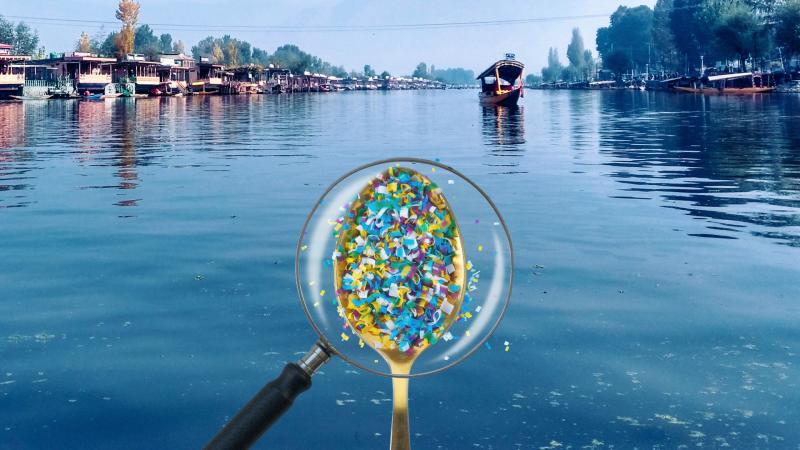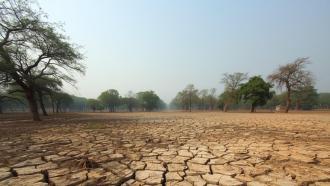
Microplastics are tiny plastic particles, smaller than 5 millimetres, originating from sources, like microbeads in cosmetics or the breakdown of larger plastics. As a plastic, they are persistent in the environment and do not break down into biodegradable compounds. Instead, they fragment into smaller and smaller pieces. Today, microplastics have invaded every part of the earth, from the ocean floor to our atmosphere. To assess the threat they pose, we will first need to understand how these minuscule beads can travel to every corner of the planet.
New research from the Indian Institute of Technology (IIT) Kharagpur, National Institute of Technology (NIT) Srinagar, and Durban University of Technology, South Africa, has now studied the often-overlooked dynamics of microplastic pollution. Their study reveals how rainfall fundamentally transforms the characteristics and associated risks of plastic debris in freshwater systems.
Although microplastic pollution in our freshwater bodies is a pressing environmental concern, our understanding of its specific pathways and how they evolve under different conditions remains surprisingly limited. Microplastics, like fibres and pellets, originate from the breakdown of larger plastic items due to sun exposure, mechanical wear, and biological processes. Once in aquatic environments, they become persistent pollutants, posing threats to ecosystem health and, potentially, human well-being. The challenge lies in pinpointing exactly where these microplastics originate and how their journey is affected by the weather.
Did You Know? Biomagnification refers to the process by which the concentration of materials, such as microplastic particles and associated chemicals, increases in organisms as they move up the food chain, as larger organisms prey on smaller ones. |
To address this, researchers investigated the iconic Dal Lake in Srinagar, a highly urbanised lake in the Himalayas. Their primary goal was to understand how major microplastic pathways, such as stormwater runoff, wastewater treatment plants (WWTPs), littering zones, and even laundry facilities, exhibit distinct microplastic characteristics, particularly in response to continuous rainfall.
The study consisted of two main sampling phases: one conducted during a dry spell (before July 15, 2023), and another after a period of continuous rainfall (after August 1, 2023). Samples were collected from various sites representing each pathway, including stormwater culverts, WWTP outlets, littering hotspots, and laundry discharge points. To provide a baseline for comparison, reference sites in the nearby Nigeen Lake, which experiences less human impact, were also sampled.
Once collected, the samples were sieved through a series of mesh sizes to categorise microplastics into different size fractions. Visible larger plastics were carefully handpicked. Then, the microplastics on air-dried filters were counted, photographed, and categorised by colour (red, blue, black, transparent, white, yellow, green) and shape (fragment, fibre, film, pellet, foam). For a deeper understanding of their chemical composition, a subset of suspected microplastics was analysed using Fourier Transform Infrared (FTIR) spectroscopy, which identifies the polymer type. This comprehensive approach allowed the researchers to not only quantify microplastics but also to characterise their physical and chemical properties.
Their findings painted a complex and evolving journey of microplastic dynamics from the source to the lake. The researchers confirmed that microplastics are pervasive in Dal Lake, with their average abundance significantly increasing from 5.9 particles per liter (p L⁻¹) during dry spells to 10 p L⁻¹ after continuous rainfall. This surge highlights how rainfall mobilises microplastics from urban and informal settlements into the lake. This process is exacerbated by atmospheric deposition and the resuspension of previously settled microplastics from lake sediments due to altered hydrodynamics.
Wastewater treatment plants (WWTPs) emerged as persistent microplastic hotspots, consistently contributing to pollution regardless of weather. Continuous rainfall, however, dramatically intensified this, nearly doubling microplastic concentrations at WWTP outlets from 7.9 p L⁻¹ in dry weather to 14.03 p L⁻¹. This suggests that increased hydraulic loading during rainfall compromises WWTP efficiency, leading to more microplastics escaping into the environment. Stormwater outfalls showed an even more pronounced shift, with microplastic concentrations soaring from 2.5 p L⁻¹ during dry weather to 9.2 p L⁻¹ after rainfall. This substantial rise is attributed to the washing away of accumulated microplastics and plastic litter from urban landscapes into the lake.
The study also revealed distinct pathway-specific characteristics. Fibers, often originating from synthetic textiles, were dominant near WWTPs and laundry sites. In contrast, stormwater and littering sites were primarily dominated by fragments, which are typically derived from the breakdown of larger plastic debris. A particularly concerning observation was the presence of black particles, exclusively near stormwater outlets, which were confirmed as rubber from tire and road wear abrasion.
Continuous rainfall not only affected the quantity of microplastics but also altered their chemical profiles, particularly near stormwater outlets. The researchers discovered the emergence of new polymers, such as polyurethane (PU), acrylonitrile butadiene styrene (ABS), and polyvinyl chloride (PVC). These polymers are often associated with road dust and shoe industry waste, further highlighting the diverse sources mobilised by rain.
The diversity indices, which measure the types of microplastics, generally increased after rainfall, indicating a greater complexity in the composition of the microplastic community. This suggests that rainfall acts as a dispersive force, redistributing microplastics from various upstream sources and reshaping the overall microplastic signature in the lake. While littering sites showed higher diversity in dry spells reflecting localised accumulation, rainfall tended to homogenise this diversity by washing materials downstream.
Crucially, the risk assessment identified stormwater and WWTP pathways as significant contributors to microplastic-related toxicity. The Pollution Risk Index (PRI) at stormwater outlets jumped from a low risk during dry spells to a considerable risk after continuous rainfall. This dramatic increase was driven by a rise in high-hazard polymers, like PVC, PU, and ABS, which are more mobile during rainfall. While WWTPs showed a relatively stable moderate PRI, the Hazard Index (HI) still increased, indicating the persistence of toxic polymers even under changing hydrological conditions.
This research significantly advances our understanding of microplastic dynamics by systematically comparing distinct pathways and their pollutant signatures under continuous rainfall. However, the study used composite grab sampling, which provides limited temporal resolution and potential underestimation of small microplastics due to visual sorting and FTIR characterisation. The use of zinc chloride for density separation is effective; however, it also raises some toxicity concerns.
Nevertheless, by spotlighting key pathways and demonstrating how rainfall changes microplastic movement, it provides essential evidence for targeted interventions. This includes advocating for climate-resilient stormwater management, upgrading wastewater treatment plants to capture microplastics better, and implementing more stringent regulations on high-risk polymers. In a rapidly urbanising and climate-vulnerable region like the Himalayas, such insights are invaluable for mitigating microplastic pollution and safeguarding the health of aquatic ecosystems, and by extension that of humans.
This article was written with the help of generative AI and edited by an editor at Research Matters.






